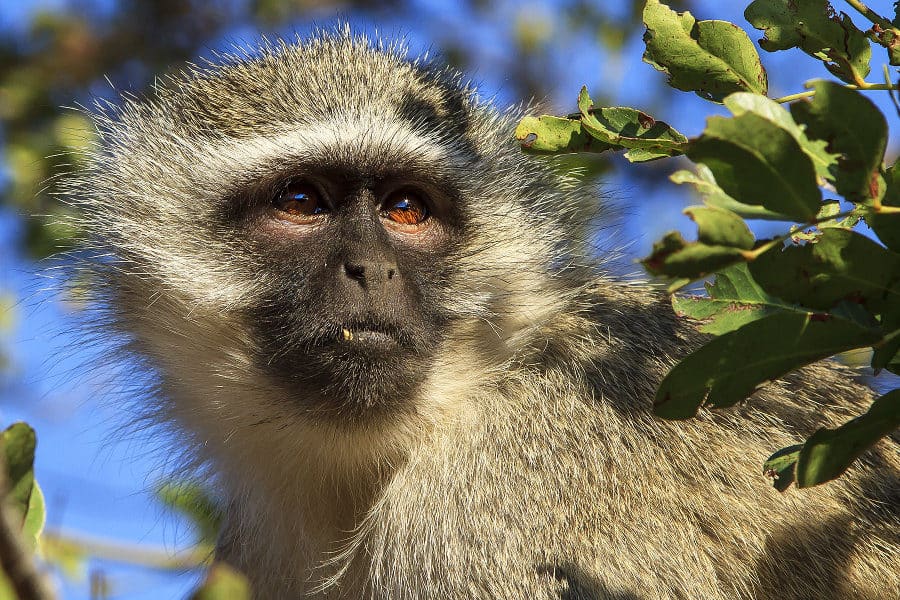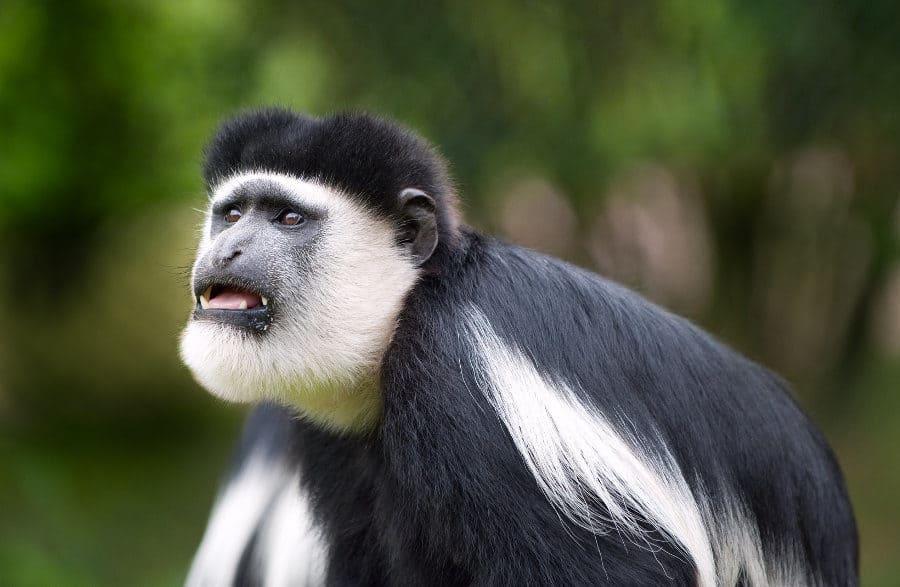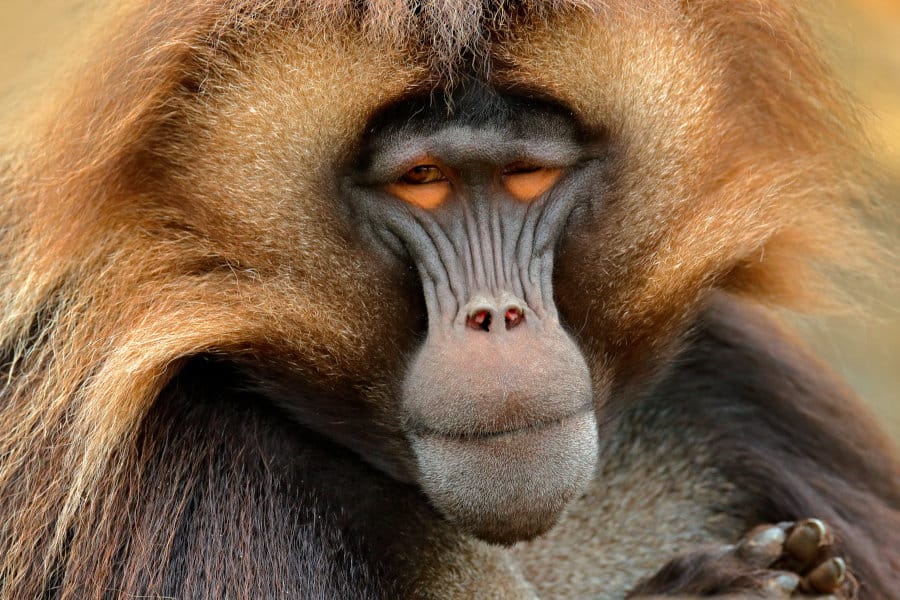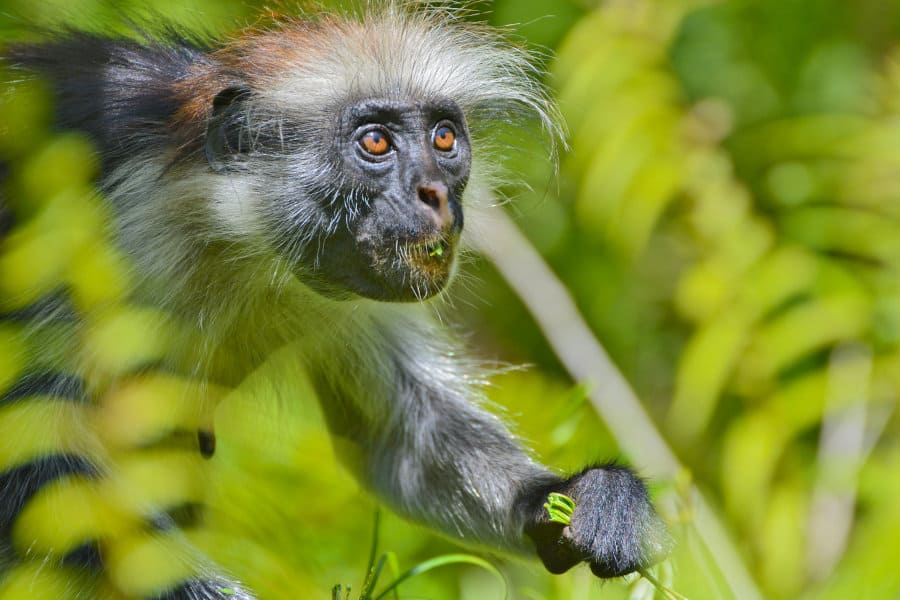Vervet monkeys have cute black faces and blue testicles. They gather in huge troops all across sub-Saharan Africa and provide a mesmeric safari encounter.
As beautiful as they are, vervet monkeys are hugely misunderstood creatures. They are considered rampant thieves and are often shot by people as pests. As the urban world expands, these monkeys are on the front line of human wildlife conflict.
Visit Africa and there is a very good chance you will encounter a vervet monkey, sometimes on safari but also in a town or on the beach. They are animals that instantly create a connection to your wild side.
This ultimate guide to vervet monkeys is all about the love. You will learn about these incredible creatures as well as the threats to their survival.
Know a Vervet Monkey When You See One
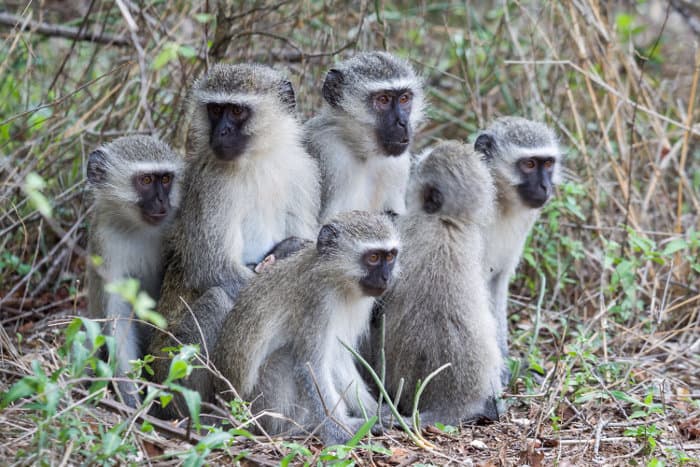
Apart from being Africa’s most abundant monkey, vervets have a highly distinctive appearance. Black faced with blue balls they are one of the easiest African animals to identify.
Their fur is a colour somewhere between olive green and grizzled grey. A white fringe surrounds their black faces and their tales are topped by a slither of black.
Males are more conspicuous. For most of the year they show off pale blue testicles. During mating season these testicles turn bright blue, a flamboyant show to suggest their suitability as a mate!
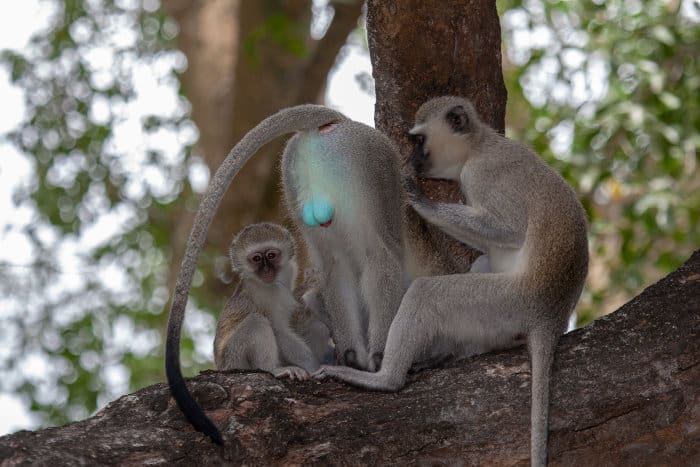
Vervets can also be identified through their troop behaviour. They are highly social animals who typically live and travel together, in comparison to some monkeys who can be solitary or bashful.
So remember, if you see a monkey with a black face then look around for more. Then confirm your vervet monkey sighting by confirming the blue balls.
Basic Vervet Monkey Facts

Distribution and habitat
The most widespread and abundant of all the African monkeys, vervet monkeys inhabit most of East and Southern Africa.
They are prevalent just about everywhere their habitat needs are met. Vervets love acacia woodland, especially close to water. But they can survive in most woodland habitats and also live on savannah plains, especially at higher altitudes where there are less predators.
Flexibility and adaptation has been integral to their success. Vervet monkeys can survive in tropical rainforest, arid desert, seasonal swamps and high-altitude plains. They just need daily access to water and a tree to sleep in.
Predators

Living in trees is part of a vervet monkey’s defence. They are vulnerable to all the big African predators, such as lions and hyenas, as well as smaller cats like caracal and serval. However, they are too small a meal for large lion prides and too big a challenge for some cats.
Crocodiles and large snakes commonly prey on vervet monkeys, along with many birds of prey. Large eagles can swoop and kill, so these monkeys rarely venture further than half a kilometre from the trees.
Leopards are the nemesis of the vervet monkey. Leopards also live in trees and can hunt successfully on the branches.
Chacma baboons are the vervets other main predator. They kill the monkeys for meat and also to protect their own food source, especially in arid habitats.
An omnivorous diet
These monkeys take their nutrition from young leaves and shoots. They can spend an entire day in a tree eating its leaves, but are also comfortable crossing the savannah eating fresh grass.
Bark and flowers are also important to their diet, along with roots, seeds, fruit and bulbs. While they live in acacia trees they struggle to eat acacia leaves. That is because African acacias implant distasteful chemicals in their leaves to ward off herbivores.
Like many primates, vervet monkeys are actually omnivorous. They supplement all their greens with eggs, insects, baby birds and the odd rodent.
Size and weight

These are medium sized monkeys that can grow above half a metre in height. Their tails are long and elegant, curling up to the sky with the tip twisting down.
Male vervet monkeys weigh up to 6-8 kg and are both larger and heavier than females.
Breeding
These charming monkeys are insatiable breeders. Breeding is seasonal and gestation takes 20 weeks.
A single baby is born and clings to its mother for the first few weeks of life. After four to six months the baby has been weaned and adopts newfound independence.
That gives the female a short window to breed and restart the cycle. The troop grows and grows as most females reproduce every single year. Females will have different mates over a lifetime but it is rare for them to have multiple mates during a single breeding season.
Vervet Monkeys Behave Just Like People!

Vervet monkeys share a scarily high number of similarities with ourselves. While we are genetically closer to chimpanzees, our behaviour is more like vervet monkeys, an animal with one of the most complex social structures in the wildlife world.
As you read about vervet monkey behaviour think about your own social networks and structures. You will discover an enormous number of similarities!
Living in large social troops
Vervets live in large troops of 10 to 50 or more monkeys. Sometimes these troops are subdivided into smaller troops. It’s like a large group of friends or a family unit. Different people socialise together at different times but all are part of the same overall troop.
Troops are mostly made up of adult females and infants. Their social structure is stable and led by dominant matriarchs (the women). Females with the highest maternal social status are at the top. The rest of the troop competes to groom high ranking females because a tight bond with the matriarch can get them more food and status.
Males leave the troop when they reach sexual maturity. Usually they leave with a cousin or another male in the same situation.
Adult males move between troops throughout their lifetime. Males live with a troop, instead of forming bachelor troops. However, they are regularly usurped by new arrivals or simply move on, believing the grass is greener on the other side (which isn’t necessarily so 🙂 ).
Inter and intra-troop relationships
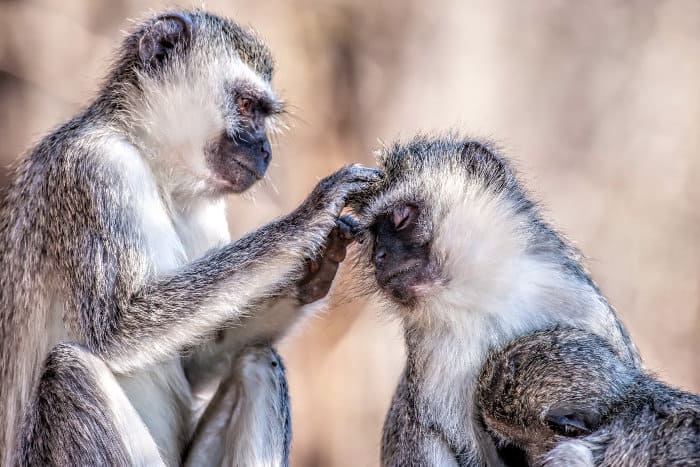
Grooming is a very important part of a vervet monkey’s day and they groom for several hours every day. Subservient individuals do proportionally more of the grooming, while dominant individuals sit back and enjoy being groomed!
Some monkeys are friendly with each other. But other monkeys are nasty pieces of work. They get aggressive towards others and try to bully themselves into positions of power.
Aggression towards others, especially weaker individuals, is common in most animal societies. Vervet monkeys are also spiteful.
Many animals use aggression to improve their position. Vervet monkeys become malicious and mean for no apparent reason. They are one of very few animals to do this.

Like the human world, some individuals are just plain cruel. For example, rather than simply steal and eat a relative or rival’s food, they destroy it instead.
Vervet monkeys are also distinctive in the way they react differently to others. Troops are friendly with some other troops but highly aggressive and confrontational with others. The monkeys can display kindness with strangers yet deliberately hurt their closest relatives.
Most animals behave in a way that best aids their survival. Vervet monkeys have a mind of their own. Their complex relationships suggest discrimination as the monkeys will behave differently dependent on the day and the situation. One day they will be friendly to the same monkey they had been bullying the day before!
Conflicts can occur and troops can split. Or different troops can become friends and join up as a single troop! Not only do vervet monkeys recognise different relationships with different monkeys, they understand the relationships between other individuals. Very few other animals demonstrate this behaviour.
Caring for juveniles and a motherly instinct
Mothers love to care for babies. In fact, vervet monkey females are so eager to mother that they have reportedly stolen babies from other troops.
After birth a baby clings to its mother most of the time. However, the baby is shown off to other females and the rest of the troop enjoys a turn grooming and caring for the newborn.
Different vervet monkeys behave differently and this is fascinating to researchers. For example, one mother will not allow any other female to carry their child, while another mother will happily leave their offspring in the hands of any interested female.
Most vervet monkeys spend their first year in the care of their mother and females who have not reached sexual maturity. But some mothers leave the troop and never return, so the infants are cared for by aunts, grandmothers or cousins!
An incredible range of vocalisations

Vervet monkeys have many hundreds of different calls or vocalisations. Our vocabulary runs to thousands of words and so does a vervet monkey’s.
Researchers have identified over 30 different kinds of alarm call. These different calls are believed to reflect specific threats. So the alarm shout for a nearby human is different to that of a nearby leopard or eagle.
All these vocalisations are incredible because vervet monkeys can respond to both the call and the caller. In essence they have invented their own language.
As an example, if one monkey makes the leopard call, all the other monkeys learn of a specific threat. Yet the monkeys can respond to that threat based on their knowledge of the caller.
Think of it from a human perspective. How do you react when you hear somebody shout for help? And how is it different if you hear your spouse or child shout for help?
The same applies to monkeys. They behave differently dependent on who raised the alarm. Vervet monkeys can identify each other through their vocalisations, the same way we recognise our friends and family by their voice.
Threats to Vervet Monkeys

Vervet monkeys are classified as an animal of least concern on the IUCN Red List. However, the scientific data is limited and out of date. We simply do not know the current vervet monkey population and whether it is declining or stable.
Many persistent threats to their survival need to be challenged.
Use in scientific research
Unfortunately, some people in the world want everything for themselves. They claim to make the world better through science, but all they do is make the world better for one species.
Due to their behavioural and genetic similarities, vervet monkeys are commonly used in scientific research. Researchers use vervets to test out new drugs and test reactions to certain stimuli.
They use vervet monkeys to test the things they don’t want to test on people.
Vervet monkeys as pets

Why anybody wants a monkey as a pet is completely beyond us. 18 US states have no restrictions on having monkeys as pets. It’s legal to keep pet monkeys in the UK with a license.
Search for vervet monkeys online and one of the top hits concerns how much does a vervet monkey cost! Apparently you can buy one for around a thousand dollars!
Monkeys are wild animals not pets, but not everyone thinks that way, perhaps because not everyone has experienced the beauty and space of their natural habitat.
Bushmeat and accidental trapping
These abundant monkeys are a popular meal for many people across Africa. They have been captured as bushmeat for thousands of years. Vervets may also end up being snared in traps intended for other animals.
Conflict between humans and “pests”

As the human world expands it takes over the wilderness. Woodland is chopped down and savannah is turned into roads and shopping malls.
Humans have invaded the vervet monkey habitat and then blamed the monkeys for raiding their crops or kitchens.
Let’s think about that for a moment. These monkeys are experts at finding food, so they climb through windows, open cupboards, wander across plantations and take what they please. Just like they have always done.
You can’t take away the wilderness and then expect vervet monkeys to behave the same way people do. Of course the monkeys will open kitchen windows and eat crops. They can’t go to the shop to buy groceries! And the crops and kitchens now stand in place of the monkey’s original food source!
This conflict turns nasty. Vervet monkeys are shot and killed as they are considered a pest or nuisance. As a pest species they are demonised, so people see monkeys as a threat to be challenged and exterminated.
The only solution is to accept that we have invaded their habitat, so the least we can do is be proactive in finding ways to coexist in harmony with wildlife.
Encountering Vervet Monkeys in the Wild
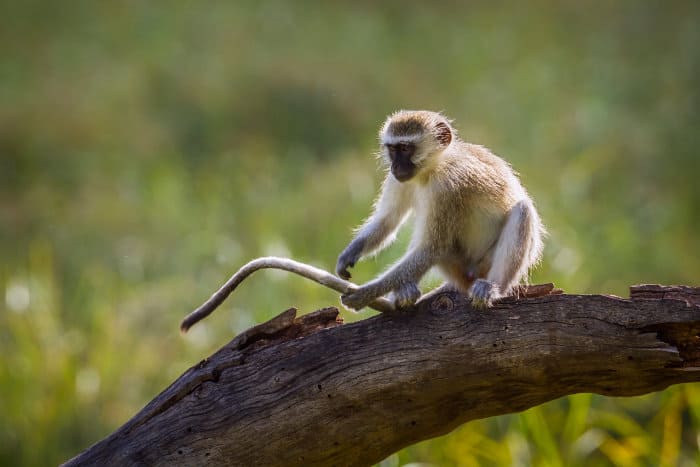
A captive environment is no place to experience vervet monkeys complex behaviour and social structure. You need to see these animals in the wild.
Fortunately, vervet monkeys are one of the most common sights on an African safari. You can see them in national parks in all the main safari countries.
They are usually a daily occurrence on any Tanzania safari or Kenya safari. These monkeys are common in most of Southern Africa’s main safari destinations, including Chobe, Kruger and the main Zimbabwe safari destinations.
Encounters with vervet monkeys are also part of a visit to Uganda or Rwanda. You may even see these monkeys when visiting a rainforest on a gorilla trekking experience.
Remember, these monkeys also live in areas populated by humans. This is especially prevalent all along the Indian Ocean coastline.
Vervet monkeys roam through the forests of Kenya and can be seen next to the Indian Ocean in destinations like Diani Beach. You will find them all along the South African coastline, but especially around the Wild Coast.
Whenever and wherever you see a vervet monkey it will be a raw connection to your wild side. Let’s hope that these monkeys continue to thrive and can remain one of the iconic impressions of an ancient continent.
